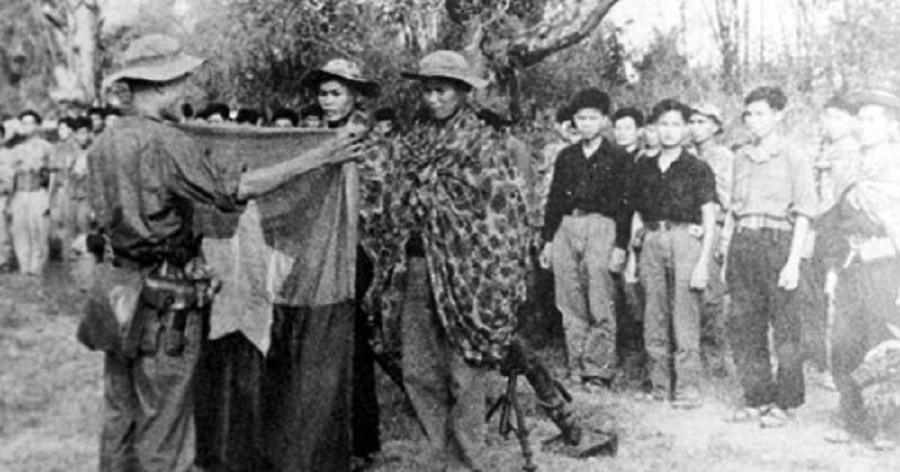
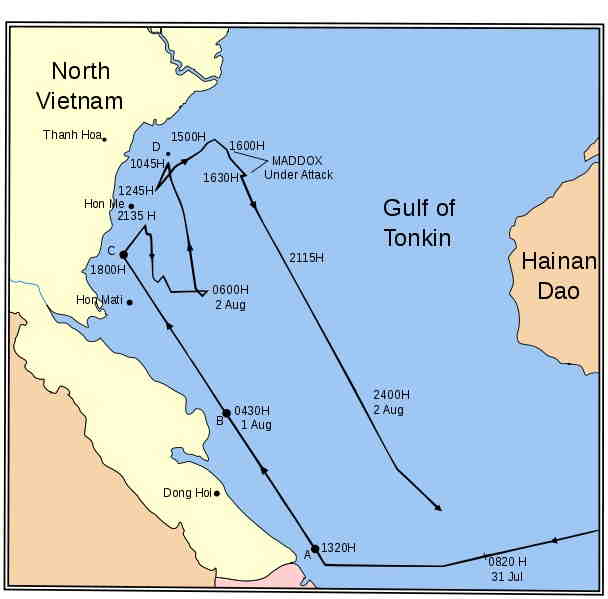
The Gulf of Tonkin Incident occurred in August 1964 and is considered a major event in the history of the Vietnam War. The incident began on August 2, 1964, when the U.S. destroyer USS Maddox was engaged in a routine intelligence mission in the Gulf of Tonkin, off the coast of North Vietnam. The Maddox encountered three North Vietnamese torpedo boats and engaged in a brief battle with them, damaging one and driving the others away. On the night of August 4, 1964, the Maddox and another destroyer, USS Turner Joy, reported an attack by North Vietnamese torpedo boats. The U.S. responded with a retaliatory air strike, and President Lyndon Johnson used the incident as a justification for the Gulf of Tonkin Resolution, which gave the President the power to escalate the war in Vietnam.
The U.S. had been involved in the region since the French Indochina War in 1954, and had been providing financial and military aid to the South Vietnamese government to help fight the Viet Cong. The incident in the Gulf of Tonkin was a major event in the Vietnam War, as it gave President Johnson the authority to launch a massive bombing campaign in North Vietnam and send ground troops to fight in South Vietnam.
In the years since the incident, it has become clear that the reports of an attack on the Maddox were exaggerated, and the incident was probably not a deliberate attack by the North Vietnamese. The Pentagon Papers, published in 1971, revealed that the Maddox was on an intelligence mission and was engaging in provocative behavior, and that the U.S. had used the incident as a pretext for military escalation.
In the aftermath of the incident, the U.S. and North Vietnam engaged in a long, bloody conflict that lasted for more than a decade, resulting in the death of millions of people and the destruction of much of the country. The Gulf of Tonkin Incident was a turning point in the Vietnam War, and a reminder of the power of a president to make decisions that can have far-reaching consequences.
The Battle of Ia Drang Valley was a series of major battles in the Vietnam War, fought by American and South Vietnamese forces against the North Vietnamese Army (NVA). It took place in the Ia Drang Valley of the Central Highlands of Vietnam from November 14 to November 18, 1965. The battle was one of the first major engagements between the two sides, and the first large-scale use of the United States Army's airmobile division.
The battle began on November 14, when the 2nd Battalion, 7th Cavalry Regiment, 1st Cavalry Division, under the command of Lieutenant Colonel Hal Moore, launched an attack on an NVA camp in the Ia Drang Valley. After a fierce battle, the 2nd Battalion captured the camp and drove off the NVA forces. However, the NVA forces regrouped and launched a counterattack, inflicting heavy casualties on the Americans. Moore's forces held off the NVA attack and managed to hold the camp, though they suffered more than 80 casualties themselves. On the following day, November 15, the 3rd Battalion of the 7th Cavalry Regiment was sent to reinforce Moore's men.
The NVA forces launched another attack on the Americans, this time with a larger force. The Americans were once again successful in defending the camp, this time with the help of air support from U.S. helicopters. The battle lasted until November 18, when the NVA forces finally withdrew. The Battle of Ia Drang Valley was significant for several reasons. It was the first major battle between the two sides in the Vietnam War, and the first large-scale use of the U.S. Army's airmobile division. It also marked the first time that U.S. forces had used helicopters in combat, and it highlighted the importance of airpower in modern warfare. In addition, the battle was one of the bloodiest of the Vietnam War, with more than 1,200 U.S. and 2,000 NVA casualties.
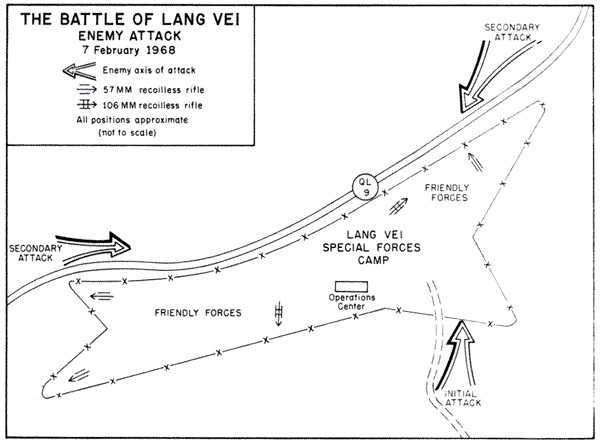
The Battle of Khe Sanh was a major confrontation of the Vietnam War fought from January 21 to July 9, 1968, in the Quảng Trị Province of Vietnam. It was fought between North Vietnamese forces and the forces of South Vietnam and the United States. The U.S. and South Vietnamese forces were defending the Khe Sanh Combat Base, which had been established in 1961 as part of the Strategic Hamlet Program.
The battle began on January 21, 1968, when the North Vietnamese launched a major offensive against the base, using infantry, tanks, and heavy artillery. For the next several months, the base was under siege. The U.S. and South Vietnamese forces held their ground, despite heavy losses and the overwhelming numerical superiority of the North Vietnamese forces. In the early part of the battle, the U.S. and South Vietnamese forces relied heavily on air power to support their ground troops. The U.S. Air Force conducted thousands of air strikes against North Vietnamese positions, while the U.S. Navy provided close air support for the ground troops.
In addition to air strikes, the U.S. and South Vietnamese forces also conducted amphibious assaults, artillery barrages, and psychological warfare operations. The North Vietnamese forces continued to press their offensive against the base, and by March 8, the U.S. and South Vietnamese forces had been pushed back to the perimeter of the base. However, despite the siege, the U.S. and South Vietnamese forces managed to hold their ground until April 8, when the North Vietnamese forces finally withdrew.
The Battle of Khe Sanh was one of the longest and bloodiest battles of the Vietnam War, with heavy losses on both sides. Despite the North Vietnamese forces' numerical superiority, the U.S. and South Vietnamese forces managed to hold their ground throughout the 77-day siege, inflicting heavy losses on the enemy and preventing them from capturing the base. The battle was seen as a major victory for the U.S. and South Vietnamese forces and helped to bolster the morale of the troops.
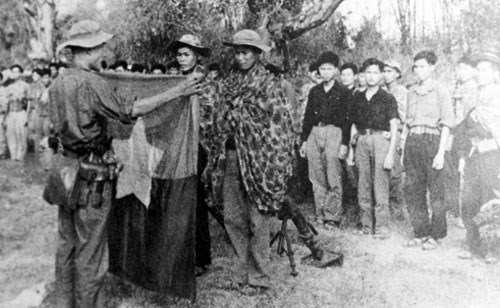
The Tet Offensive was a series of surprise attacks conducted by the Viet Cong and North Vietnamese forces between January 30 and September 23, 1968, during the Vietnam War. The attacks were intended to surprise and overwhelm U.S. and South Vietnamese forces, and to drive them out of the country. The offensive was named for the Vietnamese New Year, Tet, which began on January 30.
The attacks began with simultaneous surprise attacks on numerous cities and military bases throughout South Vietnam by the Viet Cong and North Vietnamese forces. U.S. and South Vietnamese forces were initially taken by surprise and suffered heavy casualties. However, they quickly recovered and were able to repel the attackers. Despite their initial success, the communists were unable to hold on to their gains, and the offensive ended in failure for them.
Although the Tet Offensive was a military defeat for the communists, it had a major psychological impact on U.S. public opinion. The surprise nature of the attacks and the heavy casualties suffered by U.S. and South Vietnamese forces led to a dramatic increase in domestic opposition to the war. This, in turn, led to increased pressure on the Johnson administration to negotiate an end to the war.
The Tet Offensive redefined the Vietnam War and had a lasting impact on U.S. foreign policy. The failure of the offensive showed the futility of relying on military force to achieve political objectives, and demonstrated the importance of understanding the motivations and cultures of the people involved in a conflict. It also highlighted the need for greater international cooperation in resolving conflicts, and the importance of diplomacy and negotiation.

The Battle of Huế was a major military engagement during the Tet Offensive of the Vietnam War. It was fought between the People’s Army of Vietnam (PAVN) and the South Vietnamese Army of the Republic of Vietnam (ARVN), as part of the larger Tet Offensive. It was also part of the larger U.S. effort to prevent the fall of South Vietnam.
The Battle of Huế began on January 31, 1968, when the PAVN launched a massive surprise attack on the city of Huế, a major cultural and spiritual center of Vietnam. The city was defended by the ARVN and the United States Marines, who were sent to Huế to support the ARVN. During the battle, the PAVN and ARVN fought for control of the city for more than a month. The Battle of Huế was a fierce and bloody battle, with both sides suffering heavy casualties. The PAVN managed to capture most of the city, and held it for more than a month before being driven out by U.S. and South Vietnamese forces in March.
During the battle, numerous atrocities were committed by both sides, including the killing of unarmed civilians and the destruction of historical sites. The Battle of Huế was a major turning point in the Vietnam War. It marked the beginning of a major shift in strategy for the United States and South Vietnam, as they began to focus more on pacification and nation-building programs. It also highlighted the need for more effective counterinsurgency tactics, as the PAVN had demonstrated their ability to effectively use guerrilla tactics against the U.S. and South Vietnamese forces.
The Battle of Huế represented a significant defeat for the United States and South Vietnam, as it was one of the few occasions during the Vietnam War when the North Vietnamese forces were able to capture and hold a major city for an extended period of time. The battle also highlighted the need for more effective tactics to counter guerrilla warfare, as the U.S. and South Vietnamese forces had been unable to effectively combat the PAVN’s guerrilla tactics. The Battle of Huế would ultimately lead to the withdrawal of U.S. forces from Vietnam in 1973.
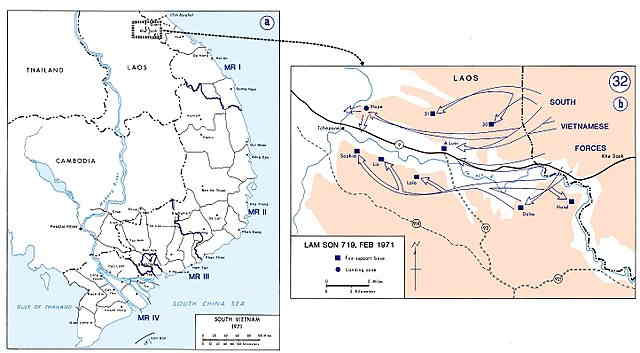
Lam Son 719 was a military operation conducted during the Vietnam War by the armed forces of South Vietnam. The operation began in February 1971 and lasted until March 1971. The objective of the operation was to cut off the Ho Chi Minh Trail, a major supply route used by the North Vietnamese to move supplies and troops into South Vietnam. The operation was named after Lam Son, the legendary leader of the Vietnamese resistance against the Chinese during the 15th century.
The operation was carried out by South Vietnamese forces, with the support of the United States in the form of air strikes, artillery, and logistical support. Over 30,000 South Vietnamese troops took part in the operation, which was the largest ground operation of the Vietnam War. The main force consisted of the South Vietnamese Army, with the South Vietnamese Air Force providing air support.
U.S. forces provided airlift, logistical support, and air strikes. The operation was successful in cutting off the Ho Chi Minh Trail and temporarily disrupting the North Vietnamese supply lines. However, the South Vietnamese forces suffered heavy casualties, and the operation was ultimately seen as a failure due to the inability to hold the territory gained. Despite this, the operation was seen as a significant achievement, as it was the first time the South Vietnamese forces had successfully engaged in a large-scale offensive against the North Vietnamese forces.
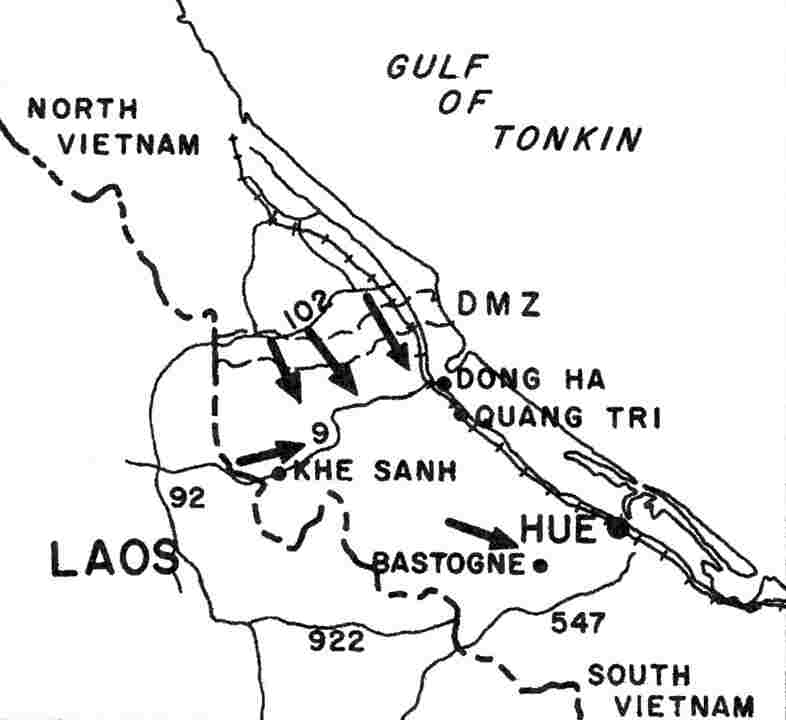
The Easter Offensive, also known as the Nguyen Hue Offensive, was a large-scale military campaign launched by the North Vietnamese Army (NVA) and the National Liberation Front (NLF) of South Vietnam against the Republic of Vietnam (South Vietnam) and its allies in April 1972. The offensive was a direct response to the signing of the Paris Peace Accords, which had ended the United States' direct involvement in the Vietnam War.
The offensive began on the eve of the Vietnamese New Year (Tết) when the NVA and NLF launched a coordinated attack on all of South Vietnam's four corps tactical zones. The NVA and NLF planned to capture the provincial capitals of Quang Tri in the north, Hue in the center, and Kontum in the Central Highlands. The NVA and NLF also hoped to inflict heavy casualties on the South Vietnamese armed forces and to gain a major propaganda victory by demonstrating the South Vietnamese government’s inability to protect its people. The NVA and NLF were able to achieve some initial success. The NVA captured Quang Tri Province, and the NLF captured much of the central city of Hue. However, despite their successes, the NVA and NLF were not able to capture any of the other three provincial capitals. As the offensive wore on, the South Vietnamese forces, with the help of US airpower, were able to push back the NVA and NLF forces and reclaim much of the territory they had lost.
By the end of the offensive, the South Vietnamese government had regained control of Quang Tri Province and the city of Hue. The NVA and NLF had been pushed back to their pre-offensive positions. The offensive had been a major setback for the NVA and NLF, and the South Vietnamese forces had prevented the North from achieving its strategic objectives.
The Easter Offensive was a major turning point in the Vietnam War. It demonstrated the North Vietnamese Army's inability to defeat the South Vietnamese forces in a conventional war, and it led to the signing of the Paris Peace Accords, which ended the war in 1973. The Easter Offensive also had a major impact on public opinion in the United States, leading to a significant decrease in support for the war.
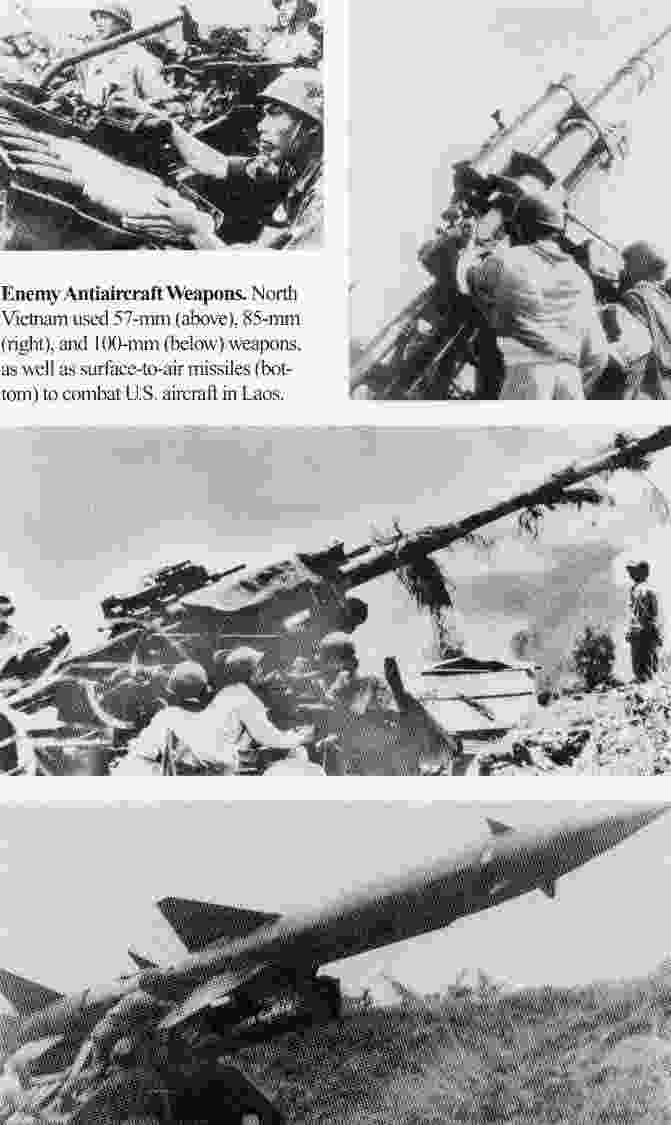
Operation Linebacker was a significant U.S. military campaign during the Vietnam War, conducted from May to October 1972. It aimed to intensify the bombing of North Vietnam after the failure of peace negotiations and the breakdown of the Paris Peace Accords.
Under the directive of President Richard Nixon, Operation Linebacker sought to exert maximum military pressure on North Vietnam to force them back to the negotiating table. The operation involved massive airstrikes targeting strategic sites, military installations, transportation hubs, and industrial centers in Hanoi and Haiphong.
The U.S. utilized advanced weaponry, including B-52 bombers, fighter jets, and precision-guided munitions, to intensify the bombardments. The operation marked a significant escalation in aerial warfare and inflicted heavy casualties on North Vietnamese forces.
Operation Linebacker played a crucial role in undermining the North Vietnamese economy, disrupting supply lines, and weakening their military capability. However, the operation also faced significant criticism for causing civilian casualties and damaging non-military infrastructure.
The intense airstrikes led to some shifts in the peace negotiations, eventually leading to a resumption of talks and the signing of the Paris Peace Accords in January 1973. As part of the agreement, the U.S. agreed to withdraw its troops from Vietnam.
Operation Linebacker had a profound impact on the course of the Vietnam War, hastening the eventual withdrawal of U.S. forces and signaling the end of direct American involvement.
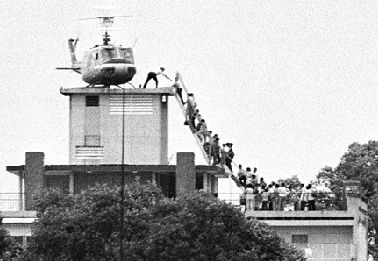
The Fall of Saigon was the end of the Vietnam War, which lasted from 1955 to 1975. It began with the North Vietnamese and Viet Cong forces' invasion of South Vietnam in March 1975, a campaign that lasted five months and culminated in the capture of Saigon (now Ho Chi Minh City). On April 30, 1975, the North Vietnamese Army (NVA) and the Viet Cong captured the South Vietnamese capital of Saigon, ending the conflict.
The Fall of Saigon marked the end of the Vietnam War and the reunification of Vietnam under the communist rule of the North. It is a significant event in modern history, as it marked the end of a long and bloody battle between the two sides and the beginning of a new era of Communist rule. The fall of Saigon began with the North Vietnamese siege of the city in March 1975, as part of their campaign to reunify the divided country. The South Vietnamese forces were soon overwhelmed by the superior numbers and equipment of the North.
As the NVA and Viet Cong forces advanced, the South Vietnamese government and its military forces were unable to hold the city, and on April 30, 1975, the North Vietnamese forces entered the city. The fall of Saigon was a major turning point in the war, as it effectively ended the conflict and brought an end to the U.S. involvement in Vietnam. The North Vietnamese forces declared victory in the war and the reunification of Vietnam under their rule. The North Vietnamese government then established the Socialist Republic of Vietnam and changed the name of Saigon to Ho Chi Minh City in honor of their leader.
The fall of Saigon marked the end of the Vietnam War and the reunification of the country. It was a significant event in modern history and a turning point for Vietnam, leading to the establishment of a Communist government in the country. The fall of Saigon is remembered as a defining moment in the history of Vietnam and Southeast Asia, and it continues to be a source of debate and controversy.